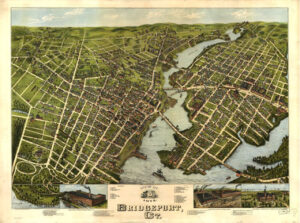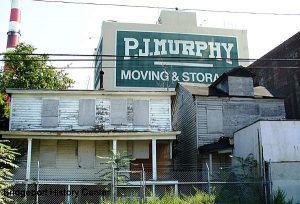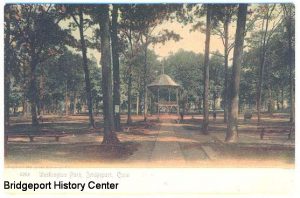Bridgeport’s Olmsted Parks

SEASIDE PARK
Seaside Park comprises two and one-half miles of gently curving shoreline on Long Island Sound. Long considered one of New England’s premier urban parks and Bridgeport’s “front yard,” it has an important place in the annals of American landscape and social history. For here is what is thought to be the very first of the waterfront “rural” parks, the forerunner of Chicago’s Grant and Lincoln Parks, Portland’s Eastern Promenade, Detroit’s Belle Isle, and all the great marine landscape designs that were to follow. It was also the first Olmsted park to be laid out after the initial triumphs of Central and Prospect Parks, and the last of the firm’s commissions to be laid out by the triumverate of Frederick Law Omsted, Calvert Vaux, and Egbert Viele. (more…)
Mary and Eliza Freeman Houses

By: Charles Brilvitch
A community of “free people of color” began to coalesce around the lower reaches of Bridgeport Harbor the same year (1821) that Bridgeport itself came into being. Comprised of freed blacks born in Connecticut, (more…)
Pembroke City Historic District

By: Charles Brilvitch, Architectural Historian
The Pembroke City Historic District is a 266-building Victorian residential neighborhood in a general two-block radius of Washington Park. Located on the east bank of the Pequonnock River opposite the city’s Downtown, the district is bounded on the North by Arctic Street; East by Beach Street; South by Clarence Street; and West by Knowlton Street. Pembroke City is listed on the State and National Register of Historic Places and enjoys Local Historic District as well.
The neighborhood comprises the core of a planned city laid out by P.T. Barnum and William H. Noble in 1850 on the peninsula that had been known since the 17th century as ‘Pembroke.’ It was intended by its progenitors to be a community of industrious, teetotling mill hands, with the prime sites surrounding the five-acre park at the center reserved for the villas of the mill owners. Barnum and Noble gave away free land to factories and church bodies in order to draw new residents over to the east side of the river, and reviewed all proposed architectural plans to ensure the harmony of the streetscapes.
Within a decade the community became the seat of the sewing machine industry in America and the vision of the developers was realized. Italian villas, French Second Empire townhouses, and Victorian Gothic churches were interspersed with Venetian Gothic row houses and Shingle Style duplexes. Some of the wealthiest individuals in Connecticut made their homes here just a few doors away from striving immigrants recently arrived in the New World.
The neighborhood was almost entirely developed by the 1890s. In ensuing decades it adapted to the needs of succeeding waves of immigrants, each one endeavoring to make their mark on its landscape by erecting their own church, synagogue, or social club. It is the largest collection of Victorian residential architecture to survive almost intact in the entire city.
Want to learn more about the Pembroke City Historic District? The Bridgeport History Center has the following materials available:
Pembroke City Local Historic District Report
The Golden Hill Paugussett Tribe

By Charles Brilvitch
The Golden Hill Paugussett tribe has been a part of Greater Bridgeport’s history from time immemorial. The original indigenous people of this region, who greeted the first European explorers and settlers and who were responsible for the pottery fragments, arrowheads, and shell middens excavated by archaeologists over the years, still manage to hold onto a tiny scrap of their ancestral territory, the Golden Hill Reservation in Trumbull. Their story is a fascinating one, sometimes tragic, more often inspirational. (more…)
